Opinion & Analysis
The Facts About Single Length Irons
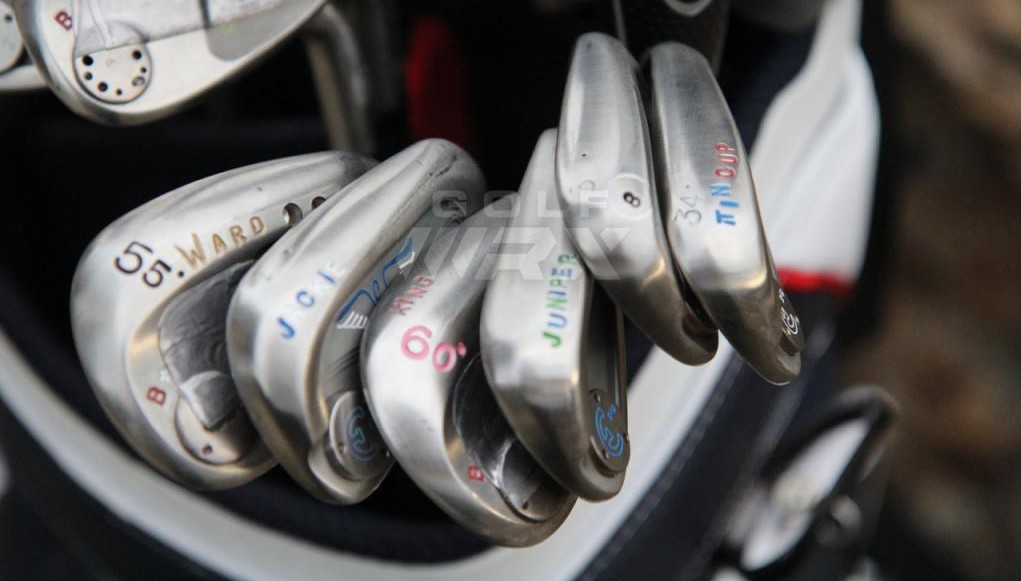
There has been a LOT of discussion lately about single-length iron sets. So much, in fact, that as a club builder and fitter single-length irons have become a daily topic of conversation.
Most of this buzz about single-length irons has been created by reigning U.S Amateur and NCAA Division I Individual champion Bryson DeChambeau, who has been very successful using a custom set of single-length irons made by Edel, a boutique equipment company in Texas.
Related: Bryson DeChambeau WITB 2016
Edel isn’t the first company to build a set of single-length irons. Tommy Armour built and marketed a set called the EQL’s in the 80’s, and there have been a few other niche companies who have been building these sets for a long time, including One Iron Golf. Recently, Tom Wishon and Jaacob Bowden released a set of single-length irons. Named Sterling Irons, they’re designed to be built shorter than others. At 36.5 inches, they’re each about the length of an 8-iron.
Related: Learn more about Sterling Irons
All of the sets listed above have one thing in common; they were designed with the sole purpose of being built to a single length. With this trend gaining more interest from the general golfing public the most popular questions are:
- Can single length irons work for me?
- Can I make my current set into a single-length set?
I’m going to explain the differences between a standard set of irons and single-length irons, why it’s difficult to convert a standard set of irons to single length and what is needed to make sure proper gapping is achieved throughout the set.
According to DeChambeau and the team at Edel, his set took many attempts to get just right. And as a club builder who is getting requests for this type of set, it’s difficult to explain the small nuances involved to golfers, especially those players looking to do this to either an existing set or to a new one built from scratch using standard OEM components. It’s also difficult to fit a golfer for this type of set because of the cost associated with having enough club heads of varying lofts to properly fit for distance gapping.
The other piece of information that I don’t believe has been mentioned enough as it pertains to the average golfer is that DeChambeau is a finely tuned athlete who swings his 45-inch driver at more than 120 mph. Most club players can only swing that fast in their dreams, and DeChambeau’s speed gives him a distinct advantage with his irons.
If you give a golfer five clubs of the same length, shaft flex, total weight, and swing weight, they will swing them at almost exactly the same speed. Give that golfer a traditional set of irons that are built with shafts that get approximately 0.5-inches longer as the iron number decreases (with the same shaft, shaft flex, swing weight and a decreasing head weight of 7-to-10 grams per club), however, and they will likely swing each club 2-3 mph faster as they move up the set.
The increased clubhead speed translates into faster ball speeds in the longer irons, which is needed to maintain a consistent peak height from the lower-lofted clubs, also know as a consistent flight window. Smash Factor also slowly increases, because the reduced loft will transfer more energy into the ball (the contact is less “glancing” or oblique), creating faster ball speeds with the longer clubs.
Distance gapping can become an issue in the longer clubs with a single-length iron set, because swing speed does not stay the same as loft is reduced. That’s why DeChambeau’s custom Edel set uses bigger loft gaps (5 degrees) in the longer clubs. Wishon’s Sterling irons do not have this design, but he addressed the issue by making the faces of his long irons “hotter,” which has the same effect.
Here is where things become very difficult from a building perspective. Standard head weights for irons are not designed to be built to the same length. They are engineered for a company’s specific length progression, generally 0.5 inches between clubs.
The chart below demonstrates the difference in club head mass between standard head weights of a set built to roughly D3 and a set of single-length irons.
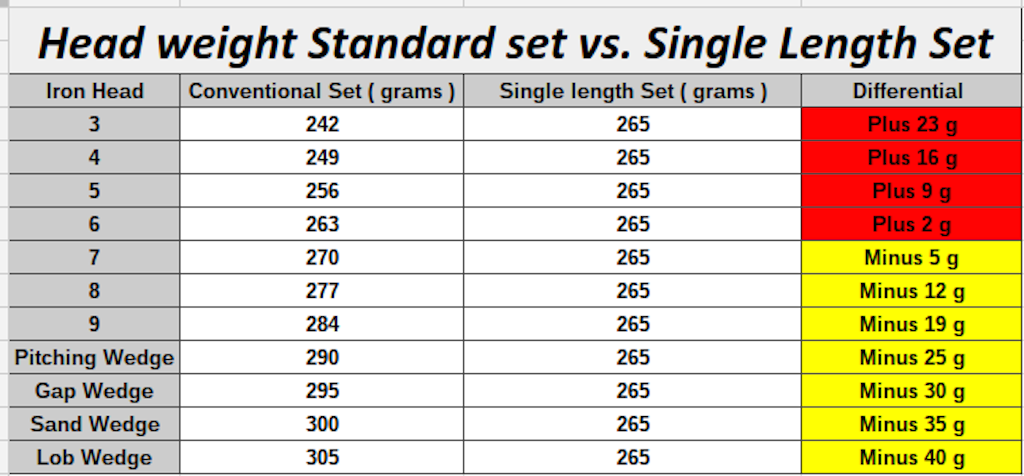 Also, the lies and loft of standard irons are not designed to be bent past a certain point, which can cause detriment to the playing characteristics of the club head.
Also, the lies and loft of standard irons are not designed to be bent past a certain point, which can cause detriment to the playing characteristics of the club head.
DeChambeau plays his entire set at 73-degree lie angle, which is more upright than the lie angle of most off-the-rack putters! Trying to bend a set of standard iron heads to these angles would either totally mar the hosels or cause them to break, especially considering many irons now are made of multiple materials and advanced constructions. DeChambeau’s Edel irons, on the other hand, are forged and more easily bent.
It should also be noted that DeChambeau’s irons are manufactured so there is no negative effect on performance. And his extremely upright lie angles are the result of his unique swing mechanics, and are not necessary to use a single-length iron set.
The chart below demonstrates standard lie angles vs. DeChambeau’s Clubs.
Going back to the issue of gapping, with a set of single-length clubs, lofts need to be adjusted accordingly to make sure that golfers have proper yardage gaps between clubs. With any player, the gapping will depending on swing speed.
The Trackman data below shows some interesting information based my testing a set of single-length irons (37.5 inches) and a set of irons built to standard lengths with frequency matched shafts, matching swing weights, and built in 0.5-inch increments.
The conclusion is that single-length irons might be the perfect solution to creating more consistency in your golf game, but just like buying a new driver or standard set of irons, be sure to visit a proper club fitter. It will take some time to find the right components to fit your needs.
- LIKE282
- LEGIT55
- WOW17
- LOL8
- IDHT10
- FLOP5
- OB5
- SHANK18
19th Hole
Vincenzi’s 2024 RBC Heritage betting preview: Patrick Cantlay ready to get back inside winner’s circle

Just a two-hour drive from Augusta National, the PGA TOUR heads to Harbour Town Golf Links in Hilton Head Island, S.C. Hilton Head Island is a golfer’s paradise and Harbour Town is one of the most beautiful and scenic courses on the PGA TOUR.
Harbour Town Golf Links is a par-71 that measures 7,121 yards and features Bermuda grass greens. A Pete Dye design, the course is heavily tree lined and features small greens and many dog legs, protecting it from “bomb-and-gauge” type golfers.
The field is loaded this week with 69 golfers with no cut. Last year was quite possibly the best field in RBC Heritage history and the event this week is yet another designated event, meaning there is a $20 million prize pool.
Most of the big names on the PGA Tour will be in attendance this week with the exceptions of Hideki Matsuyama and Viktor Hovland. Additionally, Webb Simpson, Shane Lowry, Gary Woodland and Kevin Kisner have been granted sponsors exemptions.
Past Winners at Harbour Town
- 2023: Matt Fitzpatrick (-17)
- 2022: Jordan Spieth (-13)
- 2021: Stewart Cink (-19)
- 2020: Webb Simpson (-22)
- 2019: CT Pan (-12)
- 2018: Sotoshi Kodaira (-12)
- 2017: Wesley Bryan (-13)
- 2016: Branden Grace (-9)
- 2015: Jim Furyk (-18)
In this article and going forward, I’ll be using the Rabbit Hole by Betsperts Golf data engine to develop my custom model. If you want to build your own model or check out all of the detailed stats, you can sign up using promo code: MATTVIN for 25% off any subscription package (yearly is best value).
Key Stats For Harbour Town
Let’s take a look at key metrics for Harbour Town Golf Links to determine which golfers boast top marks in each category over their past 24 rounds.
Strokes Gained: Approach
Strokes Gained: Approach is exceedingly important this week. The greens at Harbour Town are about half the size of PGA TOUR average and feature the second-smallest greens on the tour. Typical of a Pete Dye design, golfers will pay the price for missed greens.
Total SG: Approach Over Past 24 Rounds
- Scottie Scheffler (+1.27)
- Tom Hoge (+1.27)
- Corey Conners (+1.16)
- Austin Eckroat (+0.95)
- Cameron Young (+0.93)
Good Drive %
The fairways at Harbour Town are tree lined and feature many dog legs. Bombers tend to struggle at the course because it forces layups and doesn’t allow long drivers to overpower it. Accuracy is far more important than power.
Good Drive % Over Past 24 Rounds
- Brice Garnett (88.8%)
- Shane Lowry (+87.2%)
- Akshay Bhatia (+86.0%)
- Si Woo Kim (+85.8%)
- Sepp Straka (+85.1%)
Strokes Gained: Total at Pete Dye Designs
Pete Dye specialists tend to play very well at Harbour Town. Si Woo Kim, Matt Kuchar, Jim Furyk and Webb Simpson are all Pete Dye specialists who have had great success here. It is likely we see some more specialists near the top of the leaderboard this week.
SG: TOT Pete Dye per round over past 36 rounds:
- Xander Schauffele (+2.27)
- Scottie Scheffler (+2.24)
- Ludvig Aberg (+2.11)
- Brian Harman (+1.89)
- Sungjae Im (+1.58)
4. Strokes Gained: Short Game (Bermuda)
Strokes Gained: Short Game factors in both around the green and putting. With many green-side bunkers and tricky green complexes, both statistics will be important. Past winners — such as Jim Furyk, Wes Bryan and Webb Simpson — highlight how crucial the short game skill set is around Harbour Town.
SG: SG Over Past 24 Rounds
- Jordan Spieth (+1.11)
- Taylor Moore (+1.02)
- Wyndham Clark (+0.98)
- Mackenzie Hughes (+0.86)
- Andrew Putnam (+0.83)
5. Greens in Regulation %
The recipe for success at Harbour Town Golf Links is hitting fairways and greens. Missing either will prove to be consequential — golfers must be in total control of the ball to win.
Greens in Regulation % over past 24 rounds:
- Brice Garnett (+75.0%)
- Scottie Scheffler (+69.9%)
- Corey Conners (+69.0%)
- Shane Lowry (+68.3%)
- Patrick Rodgers (+67.6%)
6. Course History
Harbour Town is a course where players who have strong past results at the course always tend to pop up.
Course History over past 24 rounds:
- Patrick Cantlay (+2.34)
- Cam Davis (+2.05)
- J.T. Poston (+1.69)
- Justin Rose (+1.68)
- Tommy Fleetwood (+1.59)
The RBC Heritage Model Rankings
Below, I’ve compiled overall model rankings using a combination of the five key statistical categories previously discussed — SG: Approach (24%), Good Drives (20%), SG: SG (14%), SG: Pete Dye (14%), GIR (14%), and Course History (14%)
- Shane Lowry
- Russell Henley
- Scottie Scheffler
- Xander Schauffele
- Corey Conners
- Wyndham Clark
- Christiaan Bezuidenhout
- Matt Fitzpatrick
- Cameron Young
- Ludvig Aberg
2024 RBC Heritage Picks
Patrick Cantlay +2000 (FanDuel)
With the exception of Scottie Scheffler, the PGA Tour has yet to have any of their star players show peak form during the 2024 season. Last week, Patrick Cantlay, who I believe is a top-5 players on the PGA Tour, took one step closer to regaining the form that’s helped him win eight events on Tour since 2017.
Cantlay limped into the Masters in poor form, but figured it out at Augusta National, finishing in a tie for 20th and ranking 17th for the week in Strokes Gained: Ball Striking. The former FedEx Cup champion will now head to one of his favorite golf courses in Harbour Town, where he’s had immaculate results over the years. In his six trips to the course, he’s only finished worse than 7th one time. The other finishes include three third places (2017, 2019, 2023) and one runner-up finish (2022). In his past 36 rounds at Harbour Town, Cantlay ranks 1st in Strokes Gained: Total per round at the course by a wide margin (+2.36).
Cantlay is winless since the 2022 BMW Championship, which is far too long for a player of his caliber. With signs pointing to the 32-year-old returning to form, a “signature event” at Harbour Town is just what he needs to get back on the winning track.
Tommy Fleetwood +3000 (FanDuel)
I truly believe Tommy Fleetwood will figure out a way to win on American soil in 2024. It’s certainly been a bugaboo for him throughout his career, but he is simply too talented to go another season without winning a PGA Tour event.
At last week’s Masters Tournament, Fleetwood made a Sunday charge and ended up finishing T3 in the event, which was his best ever finish at The Masters. For the week, the Englishman ranked 8th in the field in Strokes Gained: Approach, 10th in Strokes Gained: Ball Striking and 16th in Strokes Gained: Putting.
Harbour Town is a perfect layout for Fleetwood, and he’s had relative success at this Pete Dye design in the past. In his four trips to the course, he’s finished inside of the top 25 three times, with his best finish, T10, coming in 2022. The course is pretty short and can’t be overpowered, which gives an advantage to more accurate players such as Fleetwood. Tommy ranks 8th in the field in Good Drive % and should be able to plot his way along this golf course.
The win is coming for Tommy lad. I believe there’s a chance this treasure of a golf course may be the perfect one for him to finally break through on Tour.
Cameron Young +3300 (FanDuel)
Cameron Young had a solid Masters Tournament last week, which is exactly what I’m looking for in players who I anticipate playing well this week at the RBC Heritage. He finished in a tie for 9th, but never felt the pressure of contending in the event. For the week, Young ranked 6th in Strokes Gained: Off the Tee and 6th in Strokes Gained: Ball Striking.
Despite being one of the longest players off the tee on the PGA Tour, Young has actually played some really good golf on shorter tracks. He finished T3 at Harbour Town in 2023 and ranks 20th in the field in Good Drive% and 16th in Greens in Regulation in his past 24 rounds. He also has strong finishes at other shorter courses that can take driver out of a players hand such as Copperhead and PGA National.
Young is simply one of the best players on the PGA Tour in 2024, and I strongly believe has what it takes to win a PGA Tour event in the very near future.
Corey Conners +5500 (FanDuel)
Corey Conners has had a disappointing year thus far on the PGA Tour, but absolutely loves Harbour Town.
At last week’s Masters Tournament, the Canadian finished T30 but ranked 20th in the field in Strokes Gained: Approach. In his past 24 rounds, Conners ranks 3rd in the field in Strokes Gained: Approach, 3rd in Greens in Regulation % and 24th in Good Drive %.
In Conners’ last four trips to Harbour Town, his worst finish was T31, last season. He finished T4 in 2021, T12 in 2022 and ranks 8th in Strokes Gained: Total at the course over his past 36 rounds.
Conners hasn’t been contending, but his recent finishes have been encouraging as he has finished in the top-25 in each of his past three starts prior to The Masters, including an impressive T13 at The PLAYERS. His recent improvement in ball striking as well as his suitability for Harbour Town makes Conners a high upside bet this week.
Shane Lowry (+7500) (FanDuel)
When these odds were posted after Lowry was announced in the field, I have to admit I was pretty stunned. Despite not offering much win equity on the PGA Tour over the last handful of years, Shane Lowry is still a top caliber player who has the ability to rise to the top of a signature event.
Lowry struggled to score at The Masters last week, but he actually hit the ball really well. The Irishman ranked 1st for Strokes Gained: Approach on the week and 7th in Strokes Gained: Ball Striking. As usual, it was the putter that let him down, as he ranked 60th in the field in Strokes Gained: Putting.
Harbour Town is most definitely one of Lowry’s favorite courses on the PGA Tour. In his six starts there, he’s finished in the top 10 three times, including third twice. Lowry is sensational at Pete Dye designs and ranks 7th in Strokes Gained: Total in his past 36 rounds on Dye tracks.
Lowry is perfect for Harbour Town. In his past 24 rounds, he ranks 5th in Strokes Gained: Approach, 2nd in Good Drive% and 5th in Green in Regulation %. If he figures it out on the greens, Shane could have his first win in America since 2015.
Lucas Glover +12000 (FanDuel)
This is one of my weekly “bet the number” plays as I strongly believe the odds are just too long for a player of Glover’s caliber. The odds have been too long on Glover for a few weeks now, but this is the first event that I can get behind the veteran being able to actually contend at.
Glover is quietly playing good golf and returning to the form he had after the understandable regression after his two massive victories at the end of 2023. He finished T20 at The Masters, which was his best ever finish at Augusta National. For the week, Lucas ranked 18th for Strokes Gained: Approach and 20th in Strokes Gained: Ball Striking.
Over his past 24 rounds, Glover ranks 9th in Strokes Gained: Approach and 13th in Good Drive %. Harbour Town is a short course that the 44-year-old will be able to keep up with the top players on Tour off the tee. He’s played the course more than 20 times, with mixed results. His best finishes at Harbour Town include a T7 in 2008, but recently has a finish of T21 in 2020.
Glover has proven he can contend with the stars of the Tour on any given week, and this number is flat out disrespectful.
- LIKE30
- LEGIT5
- WOW1
- LOL1
- IDHT1
- FLOP2
- OB0
- SHANK2
19th Hole
Vincenzi: The 6 biggest takeaways from the 2024 Masters
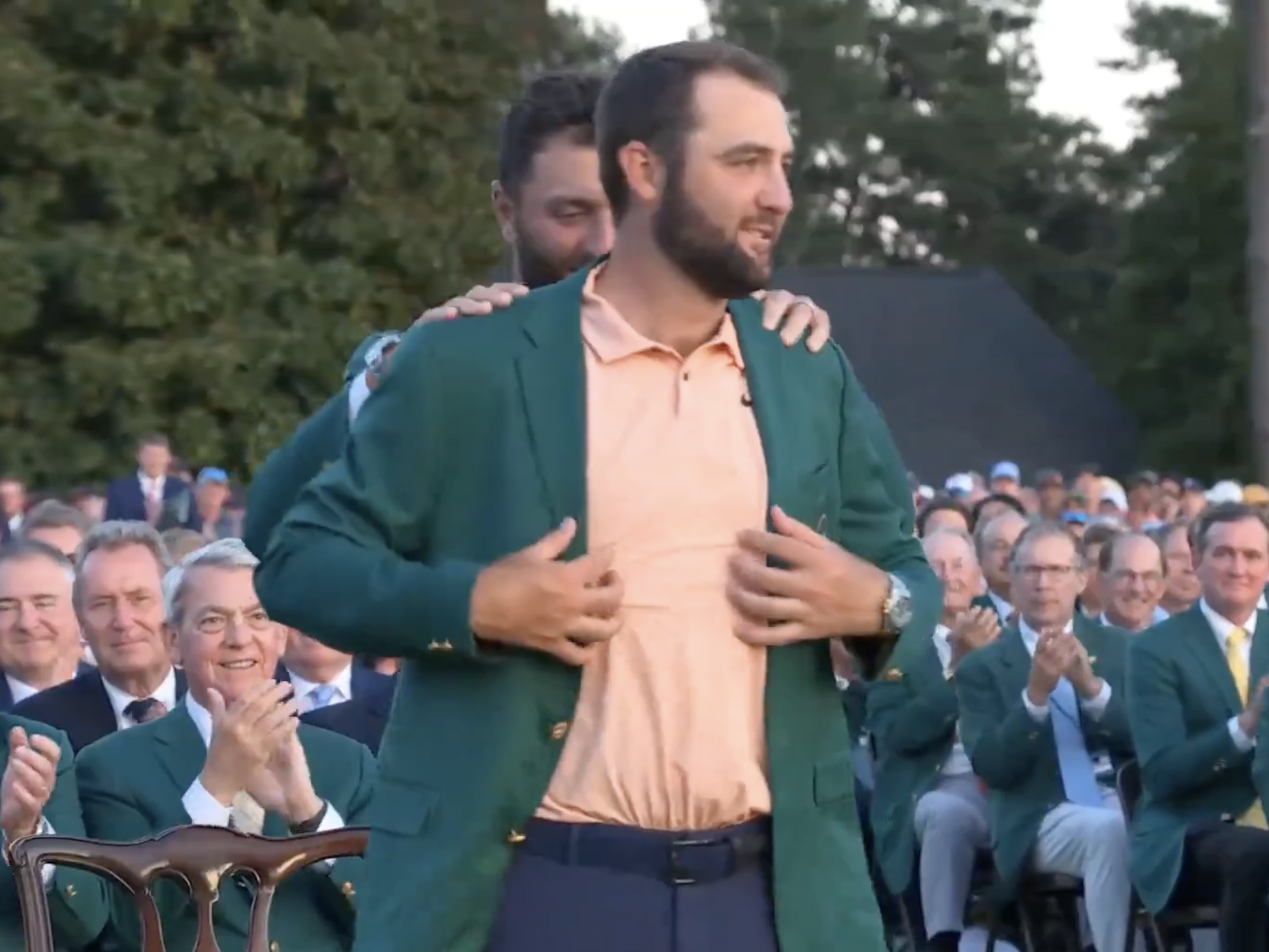
The 2024 Masters offered up plenty of excitement throughout the week with Scottie Scheffler delivering when it mattered to live up to his pre-tournament favorite tag. With the year’s opening major now in the books, here are my six biggest takeaways from the 2024 Masters.
Scheffler In a League of His Own
In the most impressive way possible, Scottie Scheffler won the Masters without having his absolute best stuff. For the week, Scottie ranked 19th in Strokes Gained: Approach, which is a category the number player in the world typically dusts the rest of the field in. After a strong approach day on Thursday, the 27-year-old lost strokes to the field on approach on Friday and Saturday, before gaining on Sunday. The iron performance was more than solid, but it was an all-around game that helped Scheffler get it done around Augusta National.
For a year or more, the narrative around Scheffler has been, “With his ball striking, if he can just putt to field average, he’ll be unbeatable.” At Augusta, his ball striking came back down to earth, but his touch around the greens and ability to manage the golf course demonstrated why he is the best player on the planet right now. For the week, Scheffler ranked 1st in the field in Strokes Gained: Around the Green and 24th in Strokes Gained: Putting.
For the time being, there is a major gap between Scottie Scheffler and the second-best player in the world, whoever that may be.
The Future is Now
Ludvig Aberg went into his first back-nine at the Masters with a legitimate shot to win the tournament. When he teed it up on the treacherous 11th hole, he was one behind Scottie Scheffler, who had just stuck one to a few feet on the 9th. By the time he approached his tee shot, which was perfectly striped down the left side of the fairway, he was two behind. Unfortunately, the 24-year-old got too aggressive with his approach at the 11th and found the water, making double bogey. Ludvig rebounded nicely and finished the event in solo second place.
With the Masters now in the rearview, it’s never been more evident that Ludvig Aberg is no longer an “up-and-comer” — he has arrived. The Swede has been an integral part of a winning European Ryder Cup team and has now contended at Augusta National. With a calm demeanor, a picture-perfect swing, and a build and stature that appears as if it was built in a lab, Ludvig Aberg is already amongst the world’s best. I’d be extremely surprised if he wasn’t in the mix at next month’s PGA Championship at Valhalla.
Nostalgia Wins
I try to avoid as many cliches as possible, but there’s something about the Masters that brings out the sentimentality in me. Tiger Woods strategically making his way around Augusta National without all of the physical tools that made him arguably the most dominant athlete in the history of sports will always be riveting, regardless of what score he shoots. Woods made it interesting until a tough stretch of holes on Saturday, but he ultimately wore down, shooting 16 over for the week in difficult conditions. It’s remarkable that the 15-time major champion was able to put together a few solid rounds of golf despite barely playing any competitive golf in 2024. As long as Woods tees it up at Augusta, we will all continue to be mesmerized by it.
Verne Lundquist’s 40th and final Masters Tournament was also a must-watch aspect of the event. The iconic voice of Lundquist and his calls throughout the years still give me chills each time I hear them. Verne is an icon of the game and will be missed in future renditions of the Masters.
The Masters also brings another element that is unique to the tournament. Former champions turn back the clock to battle with the golf course again which creates some amazing stories. There are a few that stick out this year and were an absolute pleasure to witness. 61-year-old Vijay Singh made the cut for the first time since 2018 and shot a pretty incredible even-par, 72 on Sunday. 58-year-old José María Olazábal made the cut as well, reminding us why fellow Spaniard Jon Rahm sought his valuable advice prior to his Masters victory in 2022.
Regardless of who wins, the Masters always delivers.
Bryson Moves the Needle
Plenty will disagree with me on this point, but outside of Tiger Woods, and potentially Rory McIlroy and Jordan Spieth, no one moves the needle in golf as much as Bryson DeChambeau. The uniqueness in which Bryson approaches the game has always been fascinating, and if he gets near the top of the leaderboard at any major championship, whether it’s to root for him or against him, people are interested.
It began on Monday with a pretty bizarre story of DeChambeau using 3D-printed irons that got just got cleared for use by the USGA when the week began. It once again felt like a storyline that would only be possible with a character as eccentric as Bryson. He then raced off to a first-round lead in tough conditions, reminding the world of what made him such a great golfer to begin with. He made some mistakes on the weekend, but still finished a career best T6 at The Masters.
Bryson is more than just quirky; he is a former U.S. Amateur Champion and U.S. Open who I believe will contend for more majors in the future. I will continue to root for DeChambeau, but I’m perfectly content with the fact that plenty will root against him, and I encourage those people to do so. That’s what makes it fun.
LIV Walks Away Empty-Handed
Last year, there were a multitude of questions about LIV players coming into the year’s first major. They had played very limited tournament golf, and critics of LIV questioned whether the 54-hole events were enough to sharpen the players enough to compete against the best in the world on the biggest stage.
The results were fascinating, with LIV players all over the leaderboard. Brooks Koepka held the 36- and 54-hole lead, with Phil Mickelson and Patrick Reed finishing T2 and T4, giving LIV three golfers in the top-4 of the leaderboard.
This season, with even more time removed and with some more massive additions to the roster, the intrigue surrounding LIV players at Augusta was once again palpable. While some players, including Bryson DeChambeau, exceeded expectations, I can’t help but walk away from the Masters feeling underwhelmed by the performance of the LIV players.
Brooks Koepka finished runner-up last season and is a certified major championship killer. The 5-time major champ was never involved and simply didn’t have it at Augusta. Dustin Johnson put together a putrid performance, shooting 13 over for his two rounds, making it fair to wonder if his days of contending at major championships are over as he rapidly approaches his 40th birthday.
Jon Rahm and Joaquin Niemann were both players who were amongst the favorites this week, but Rahm was faced with the daunting duties of defending champion and Niemann proved he was still not quite ready to master the quirks of Augusta National, bleeding strokes both around and on the greens.
To be fair, when all was said and done, LIV had four players in the top twelve at The Masters. Tyrrell Hatton stormed the leaderboard early on Sunday, finishing T9 and earning himself an invite back to Augusta next season. Cam Smith and Patrick Reed put together gritty performances, which isn’t too surprising considering the fact that they both absolutely love Augusta National, but neither ever felt a real threat to win. There’s no doubt the players on LIV are good, and that’s why some encouraging leaderboard positions aren’t enough. They needed to contend.
With no players part of the storyline on Sunday, I view the first major of the year as a disappointment for LIV. The players will head into next month’s PGA Championship at Valhalla with a lot to prove.
Rory’s Struggles Continues
Rory struggling at Augusta National is no surprise at this point. The four-time major champion has now had 10 attempts to complete the career grand slam and has never had a chance to win. His T2 in 2022 was deceiving, the Northern Irishman stormed the leaderboard on Sunday, but was never in contention, and never got within three shots of the winner, Scottie Scheffler.
I didn’t expect Rory to win, but I have to admit that this year felt a bit different. McIlroy played the week prior to the Masters, which he typically doesn’t do, and finished third at the Valero Texas Open. He gained 7.56 strokes on approach and 2.0 strokes off the tee, which told me that his visit with world-renowned swing coach, Butch Harmon, after the Players Championship paid dividends.
McIlroy also approached the media quite differently. He cut his pre-tournament press conference short after only 10 minutes and seemed to be laser-focused on just playing golf.
Despite the different approach to the Masters, the results were the same. McIlroy struggled over the course of the week, finishing T22 (+4) and never sniffed a decent weekend position on the leaderboard. It’s back to the drawing board for McIlroy, and I have doubts that he will ever figure it out at Augusta.
- LIKE51
- LEGIT9
- WOW4
- LOL1
- IDHT2
- FLOP2
- OB2
- SHANK7
19th Hole
Vincenzi: The 8 best prop bets for the 2024 Masters
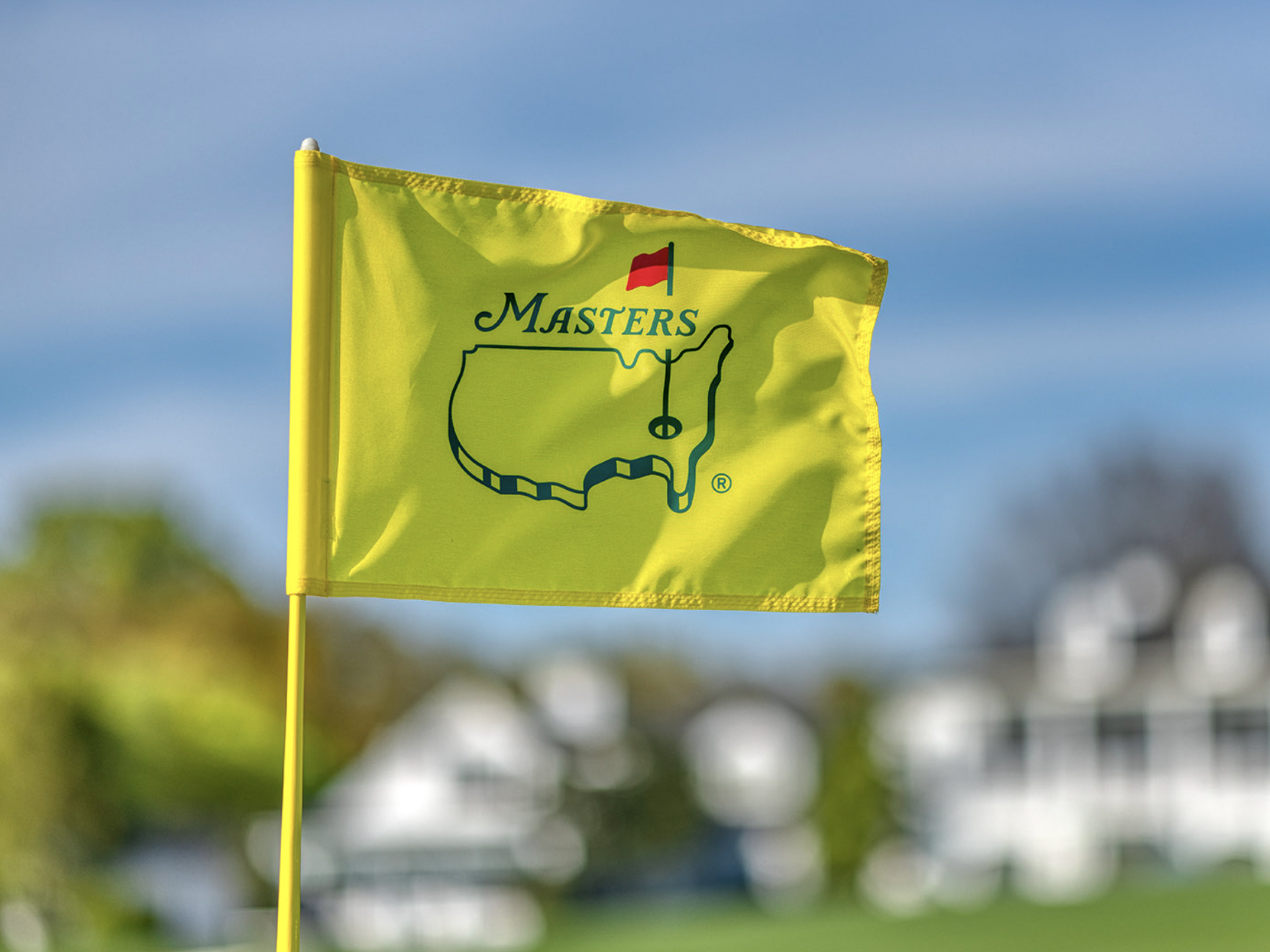
We’ve finally reached The Masters and excitement is at an all-time high. The world of golf has been fractured for the better part of two years, but for a week at Augusta National, all of the outside noise will disappear. All of the best players in the world will be together seeking to make history.
In addition to betting on The Masters champion. This is one of the few weeks of the year where there are so many more markets to explore, with value to be had in plenty of different categories.
Throughout this article, I’ll discuss all of my favorite props and players for the 2024 Masters.
Placement Bets:
Tony Finau Top 5 +750 (DraftKings):
I badly wanted to include Tony Finau in my outright betting selections, but I simply ran out of room on my card. Additionally, it’s slightly difficult to see him hitting the putts necessary to win the Masters on back nine on Sunday. However, I do strongly believe he will play great golf this week at Augusta National.
In his past 24 rounds, Finau ranks 4th in Strokes Gained: Approach is always amongst the best drivers of the golf ball in the game. Back in 2019, Finau had a great chance to win The Masters. I expect him to be hanging around over the weekend once again in 2024.
Gary Woodland Top 20 +550 (DraftKings), Gary Woodland to make the cut -110 (DraftKings):
Last season, Gary Woodland had his best ever finish at The Masters in his eleven tries. The 39-year-old finished T14 and played incredibly steady across all four rounds.
In Woodland’s most recent start at the Texas Children’s Houston Open, he struck the ball incredibly well. He led the field in Strokes Gained: Approach (+8.8) and Strokes Gained: Ball Striking (+10.0).
Gary has been working with Butch Harmon and absolutely flushing the ball both in tournaments and during practice.
Woodland appears to be healthy once again and in a great place physically and mentally. If he can build off his impressive performance at Augusta last year, he can place inside the top ten in 2024.
Additionally, the make the cut number on Woodland seems generous considering the number of players who miss the cut will be relatively small this week. Woodland is striking it well enough to make the cut even if he’s hindered by a balky putter once again.
Thorbjorn Olesen Top 20 +400 (FanDuel):
The Thunder Bear, Thorbjorn Olesen, made his Masters debut in 2013 and finished an incredibly impressive T6 for the week. In the two additional starts he’s made at Augusta National since then, the Dane has continued to be incredibly solid, finishing T44 and T21.
This week, Olesen heads into the week playing some good golf. He gained 3.8 strokes on approach and 5.52 strokes around the green at last week’s Valero Texas Open on his way to a strong T14 finish. Back in January, he won the Ras Al Khaimah Championship on the DP World Tour.
Olesen has the skill set to be successful at Augusta and seems primed for a good performance this week.
Top Nationalities:
Sergio Garcia Top Spanish Player +280 (DraftKings):
I believe Sergio Garcia can get into contention this week with the way he’s striking the ball in addition to his good vibes with a refurbished version of the Scotty Cameron that he used at the 1999 PGA Championship at Medinah.
I am slightly concerned about the emotional letdown he may face after losing in a playoff at LIV Miami, but I believe a veteran and former Masters champion should be able to regroup and focus on an event far more meaningful.
This is essentially a tournament head-to-head with Jon Rahm at +280. While Rahm deserves to be respected this week, the history of the lack of success of defending champions at The Masters is difficult to ignore.
Joaquin Niemann Top South American Player -230 (FanDuel):
While I hate paying this much juice, I don’t see a world in which Joaquin Niemann isn’t the top South American this week at The Masters. Joaco comes in playing better golf than anyone in the world not named Scottie Scheffler and has a serious chance to win the green jacket.
He only needs to beat two players: Emiliano Grillo and Camilo Villegas.
Tournament Head-to-Heads:
Justin Thomas -110 over Collin Morikawa
JT isn’t having his best season but is playing a lot better than he is getting credit for at the moment. In the past three months, there are only six players on the PGA Tour who have averaged 1.7 Strokes Gained: Tee to Green or better. Justin Thomas (+1.7) is one of the six and is currently tied with Rory McIlroy (+1.7).
Morikawa, on the other hand, has been extremely poor with his irons, which is incredibly uncharacteristic for him. I can’t help but feel like something is completely off with the two-time major champion.
Tony Finau -110 over Wyndham Clark
I explained in the placement section why I’m so high on Tony Finau this week. With how well he’s striking the ball, it seems as if his floor is extremely high. I’m not sure if he can make the putts to win a green jacket but I believe he will be in the mix similarly to 2019 when Tiger Woods emerged from a crowded pack of contenders.
Clark is a debutant, and while some debutants have had success at The Masters, it certainly poses a challenge. I also don’t believe Augusta National suits Clark as well as some of the other major championship venues.
- LIKE9
- LEGIT5
- WOW3
- LOL0
- IDHT0
- FLOP0
- OB0
- SHANK3
-

 19th Hole1 week ago
19th Hole1 week agoDave Portnoy places monstrous outright bet for the 2024 Masters
-

 19th Hole2 weeks ago
19th Hole2 weeks agoThings got heated at the Houston Open between Tony Finau and Alejandro Tosti. Here’s why
-

 19th Hole1 week ago
19th Hole1 week agoTiger Woods arrives at 2024 Masters equipped with a putter that may surprise you
-

 19th Hole2 weeks ago
19th Hole2 weeks agoReport: Tiger Woods has ‘eliminated sex’ in preparation for the 2024 Masters
-

 19th Hole4 days ago
19th Hole4 days agoTwo star names reportedly blanked Jon Rahm all week at the Masters
-

 19th Hole3 days ago
19th Hole3 days agoNeal Shipley presser ends in awkward fashion after reporter claims Tiger handed him note on 8th fairway
-

 19th Hole2 days ago
19th Hole2 days agoReport: LIV Golf identifies latest star name they hope to sign to breakaway tour
-

 19th Hole2 weeks ago
19th Hole2 weeks agoAddiction, spinal fusion, and scam artists – Everything Anthony Kim revealed in candid interview with David Feherty


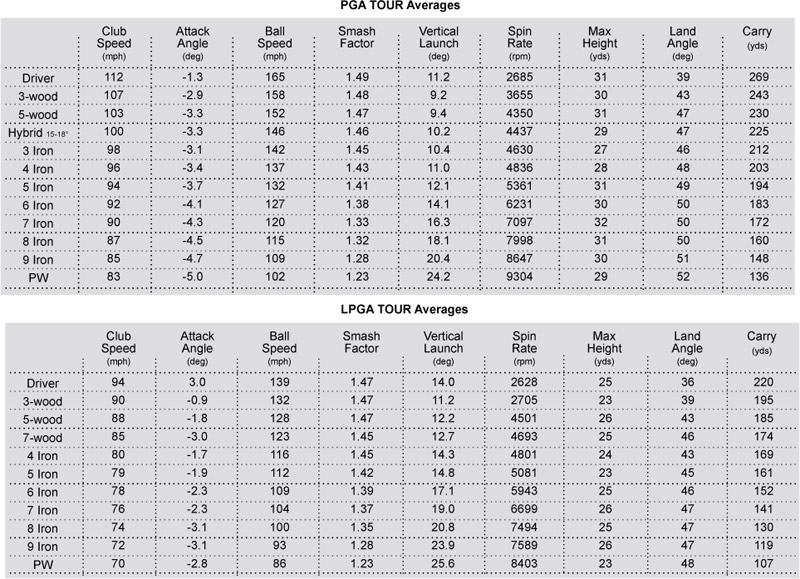
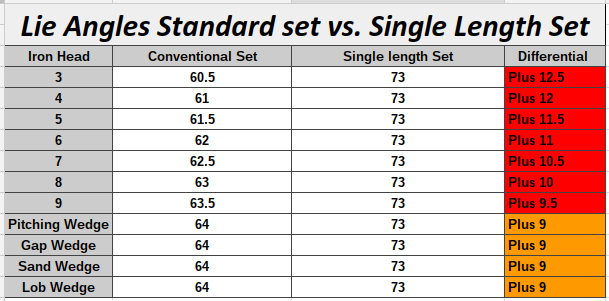
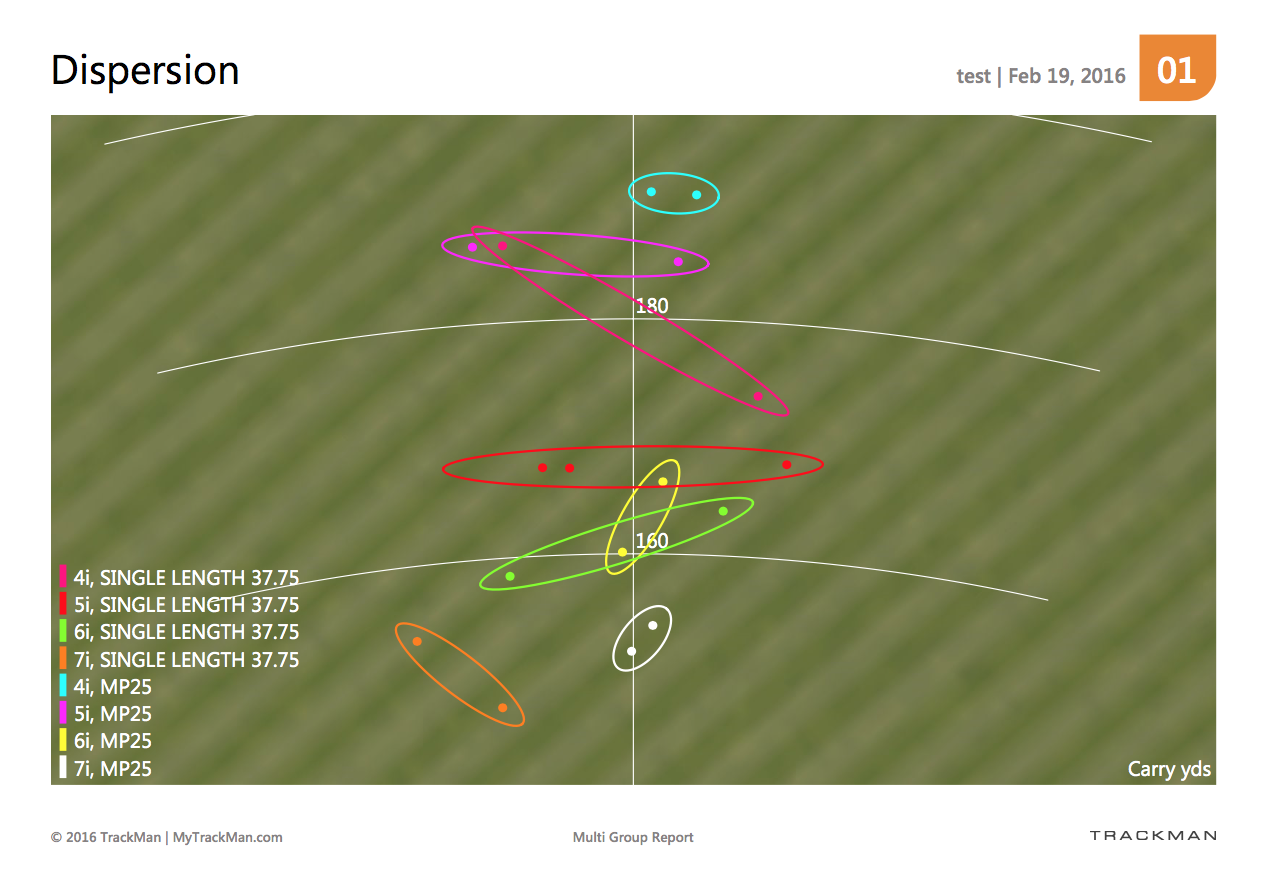



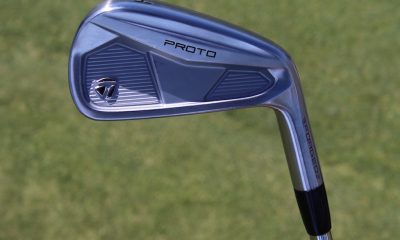

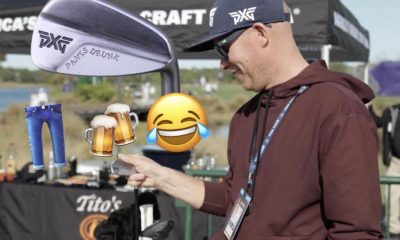

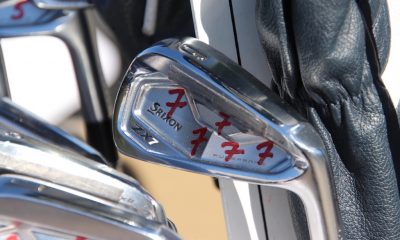

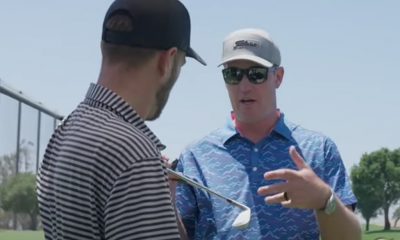



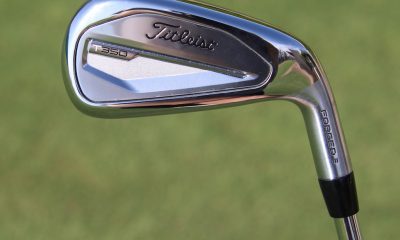















Bruce Gerhold
Mar 18, 2016 at 1:58 pm
I used conventional club heads and fabricated a set of MOI matched clubs using a 2 length concept. This could be an alternate set that a player would find useful: I have played these for several months no plans to return to variable length, variable weight clubs.
I hold advanced degrees in Mechanical Engineering where I studied the science and mathematics of moving bodies. My career was in R&D work so tinkering with club fabrication is a natural. I’ll outline my fabrication below.
The clubheads are a cavity back design with and undercut behind the face ( Hireko Prophet CB cast perimeter with a forged, hardened stainless face Note the lofts are 1 club number lower than conventional to artificially add length but I refer to conventional loft club numbers below. http://www.hirekogolf.com/golf-components/clubheads/golf-irons/dynacraft-prophet-cb-iron-clubhead.html ). I selected these based on excellent feel of the forged face inserts and the undercut offers a convenient place to add weight that is well supported mechanically and will remain on the club head. The 2, 3, 4, 5 irons are same length, same shaft, same shaft trim (5 iron), same grip. I used two techniques to add weight to the club heads so they all equaled the 5 iron ( 263 g) : first, I mixed tungsten powder and shafting epoxy forming a self leveling mix, then put the mix in the cavity allowing it to settle to the bottom of the undercut and distribute evenly. When greater than 10 grams is required, I used 1/4 oz “egg” shaped lead fishing sinkers that were flattened to fit into the undercut – one in the toe and one in the heel. I then used the tungsten powder + epoxy to trim the weight and pot in the lead pieces. Both methods function well with no weight lost while playing and practicing. The long irons are 37 inches long.
The 6, 7, 8, 9 are made similarly with weight equal to the 8 iron ( 284 g ), shaft trim of an 8 iron and no weight on the 9 iron (simply made it 3/8 shorter for constant total club MOI). The short irons are 36 inches long. Since the short irons are shorter, but with increased head weight, the club MOI equals that of the long irons as measured with a pendulum technique. Note: the MOI is the moment of inertial of the entire club about the point between the hands (pivot point for club release which is what generates speed). The concept of swingweight is not supported by science and I (and many others) take as meaningless.
I find that even though I have 2 club lengths, the ball position is roughly the same for the 2 lengths with the longer clubs played one ball forward of the short clubs.. The common set up tremendously simplifies your game and leads to solid iron play. I flattened lie angle somewhat on the 5,4 and 8,9 but hesitated to bend too much because they are a cast body (2 degree max bending recommended). My 2 length clubs play just fine with minimal lie adjustments because the 2 lengths effectively give a lie adjustment.
My results show NO SHOT DISTANCE PROBLEMS. The length of a shot depends on club loft, club momentum (speed times MASS), and hitting the sweet spot. The added club head mass compensates for the shorter shaft, and I hit much more solid shots due to a controllable club length. 9 iron 120 and 2 iron 195 with normal type spacing for the intermediate clubs.
Lawrence Savage
Mar 18, 2016 at 1:01 pm
I bought a set of 1 Iron clubs because I thought it sounded like a really good idea. These were the problems I experienced:
1. The look on some clubs (3i, 4i and particularly wedges) was a bit off putting
2. I hit shorter shots in general, even though the lofts were nearly identical to my previous set. This was an absolute confidence killer. My swing speed is very middle of the road and I found that 3i and 4i were barely longer than 5i
3. I found the shafts in the wedges a little bit whippy, which may have contributed to reduced distance
4. The larger grips took a bit of getting used to, and I went from hitting a relatively predictable draw to an semi-controlled fade
5. Chipping was much harder from Kikuyu grass because of the low bounce of 3° (except SW at 6°) – certainly it was awkward-feeling chipping with a 7i-length LW at first
6. The grooves absolutely mashed the golf balls covers. In fact if one were super particular it would be one shot one ball, so much was the scuffing. This was a real sore point since the ZAR:USD exchange rate has made decent balls very expensive now
7. I went out six shots on handicap over five months – this was the death knell for me
I eventually went back to my old set and after a year I recovered my old form, in fact I reached my lowest hcp. It was a really expensive experiment, but super glad I tried it. Maybe when I’m older I would consider them again.
Ash
Mar 18, 2016 at 12:52 pm
The article ‘borrows’ heavily from members comments in the forums. A key point left out is that Bryson D, with Edel Golf, have adjusted heads so that the weights are IDENTICAL. Missing that vital point renders this article worthless.
Gisle Solhaug
Mar 17, 2016 at 10:25 am
The advantage of single length sets of irons is that your muscle memory will only have to learn one swing for your set of irons rather than one swing for each club. The same can be achieved on a standard set of golf clubs by optimizing the weight of each club by adding a specific weight to the grip end of the club. As the ball position and club length differ on a traditional set, so must the weight of each club. The calculations to obtain this exact weight is complex and involves building a computer model of your body swinging each of your clubs. You will then have the same swing for every club in your bag, except the putter of course. By making every club the same length, the ball position will be the same for every club at setup. Therefore, the clubs will be perfectly matched when they all have the same weight and MOI. And they will all have the same Swingweight, for those of you that care about that. The disadvantage of a single length set of irons is that you still need to apply a different swing for all the other clubs in the bag. What if you could have the same swing for all the clubs? That would make the game a lot easier. Those who are interested can learn more at http://www.rational-golf.com
Large chris
Mar 18, 2016 at 1:47 pm
Not according to the book ‘physics of golf’ by Jorgenson as referred to by Dave Tutelman.
Perfectly balancing a conventional 1/2 inch progression set of irons requires specific weights added both at the butt and midway down the shaft. It can’t be done by just adding different weights at the butt only, as it is not possible to equalise the first, second and third moments of the club without adding weights at the midpoint.
Also you seem to be suggesting you can achieve the same swing with different length clubs…. Patently impossible as the lie angle is changing ie the angle your wrists are pointing at to ground out the club.
KK
Mar 16, 2016 at 7:56 pm
Very interesting but I do agree this this probably for the higher swing speed golfer. Maybe two lengths for slower swing speeds? That would be a nightmare for fitters, lol.
Tony Wright
Mar 16, 2016 at 6:59 pm
Thanks for the informative article Ryan. You mentioned Tom Wishon’s single length iron design. I know that he worked for 2 years to develop it, in partnership with a very good European player. It will be very interesting to see what happens with his design once it gets into the hands of golfers through custom club fitters. I know that he has already sold out 4 orders of single length iron heads through his supplier – the first shipment of heads from Tom to custom fitters will happen sometime later in March, and the 4th set of orders will not occur until sometime in June. None of this says that single length is going to catch on – and Tom himself says it will not be for everyone – but we will see!
Snowman9000
Mar 16, 2016 at 1:25 pm
Regarding your dispersion graphic: At least one of those club numbers should have been effectively the same in both sets. Maybe the 5 iron, maybe the 6. Yet every SL club was worse. Are you comparing an ill-fitted SL set to a well-fitted conventional set?
BTW I don’t disagree with your assessment of the obstacles involved. I have custom made 3 SL sets. Even going so far as to remove or add weight in the right places as to improve the flighting of the irons. My last set was my best, and it’s pretty good. But I still find that the “short” irons (9 & wedges) fly too high. I feel it’s because the attack is shallower. My irons are only 6 iron through wedges, so the rest of the objections don’t really come into play. I can see a 5 iron, but I can’t see any reason today for a recreational golfer to play a 4 iron, no matter the length. So for 5 or 6 irons through wedges, it’s not that hard to do, and there are definite benefits in consistency, once the right fitting is found.
With an SL set, you don’t have to fret about whether to match the clubs via swingweight, or MOI, or MBI, or balance point, etc. Which is good, because some golfers do better with descending swingweights, some with steady swingweights, some with ascending weight shafts, some with constant weight shafts, some with unitized (descending weight) shafts, etc. But the amount of testing, and of required discernment ability by the fitter and golfer, and randomness of swings during fitting, make it extremely unlikely that the golfer comes out of the fitting with the true right heft and balance for him, throughout the set. MAYBE for the test club, yes. Hopefully so.
In the SL set, all that goes out the window. If the test club is truly a good fit, so are the others.
Again, I admit that this has to be balanced against the downsides, which are distance gapping and flighting. Many golfers, if they played an SL set that truly matched their swing, might find better results even despite the gapping and flighting issues. Might.
Jason
Mar 16, 2016 at 12:55 pm
Golfers are funny. Every top 100 player in the world uses a standard set of clubs and some guy shows up out of nowhere (albeit BC is a great golfer and he obviously has had tremendous success) with a single length set and now everyone is considering changing years of familiarity for them. The lifelong equipment search for golfers continues…
Robert A Parolisi
Mar 15, 2016 at 7:37 pm
Add tape to build up the taper in the shaft, then grip down on the iron.
Al
Mar 15, 2016 at 3:18 pm
I’ve tried to do this with 2011 Tmag tour preferred MC (they have exchangeable weights and ebay allowed for a variety of options), I went with a lighter shaft Nippon 950gh HT. Basically, I had the 8-LW the same length. The 3,5 and 7 same length, didn’t use the 4 and 6 for gapping purposes. Had the 3 bent to 20, the 5i to 25 and 7i to 30. I added a heavier weight plate to the back as well as brass shaft tip weights. I was able to get them to C9-D2. Overall it was fine, I actually had some solid rounds and scored well too. Mentally I struggled looking down at the 3 and how short it was. I played the 8-LW at a length of 35.5″ and 3-7″ at 36.5″. Unfortunately I reverted back to normal lengths. I regret it now and wish I would have stayed with it longer. I have another set of shafts I can play with if I get the itch.
Scooter McGavin
Mar 15, 2016 at 12:56 pm
Sounds like something you’d need to go to a specialty shop for, because I doubt the local Golfsmith or Golf Galaxy would have the equipment or know-how to accommodate.
Bob
Mar 15, 2016 at 11:23 am
I’ve known Ryan for many years and he knows the mechanical aspects of club building as well as anyone I’ve met in my 37 years in and around the golf business. He an excellent synopsis of the positive and negative aspects of the single length approach, IF in the hands of an athletic player like Dechambeau.
TOM
Mar 15, 2016 at 10:49 am
the last paragraph sums it all up.
Ryan
Mar 15, 2016 at 10:46 am
I’m not quite ready to switch to a single length set of irons, but what do you think about a single length for wedges? It’s something I’ve been considering for awhile.
devilsadvocate
Mar 15, 2016 at 2:54 pm
Single length wedges are the norm on tour… Highly recommend not only single length wedges but single swing weight , total weight, and lie angle throughout your wedges… Only difference would be loft (obviously) and bounce… Then when you practice short game you develop a consistent bottom of the arc with your wedges… Kind of important haha
Aaron
Mar 15, 2016 at 3:33 pm
I have played my wedges (46,50, 55, 60) at the same length (off the pw) for years. The consistency is definitely easier to have when they all setup the same. It will feel only a tad odd at first on your lob wedge when you are gripping it normal and you will gain some extra yardage in that club as well, but I have found it to be easier to control them because the setup and feel is the same throughout. I don’t know that I would go to a single length set though… The idea of increasing length shafts allows you to have an increased swing speed as you go towards the long irons without the addition of actually swinging harder. The other thing that comes into play is “working the ball”. The flatter lie angle on the lower lofted clubs makes it easier to create draws and fades. I tend to change my swing quite a bit to suit the shot shape I am attempting and I don’t play the robotic swing style like Bryson. If you are someone who views golf in straight shots and the same swing as much as possible in a round I think the single length set could be advantageous.